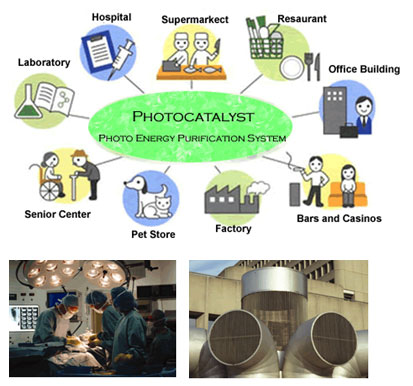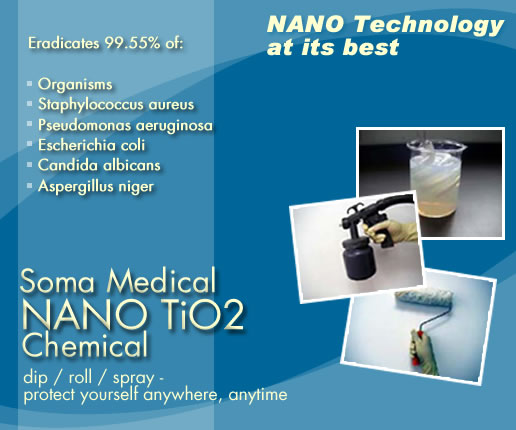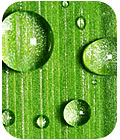| Specification |
| Product Series |
2 Sol Coating Agent |
| Main Compositions |
Nano Titanium Dioxide |
| Crystallite Structure |
Anatase |
| Average Primary Particle Size |
<8nm |
| Coagulation Index |
2-4 |
| Executing Criterion |
Q /TDIT-01-2004
GB/T 19591-2004
GB/T 19619-2004 |
| Appearance |
Bluish white / yellowish transparent liquid |
| Smell |
Odorless |
| Skin Touch |
Harmless |
| Dispersant |
Water-based |
| Origin |
Malaysia |
| Storage Condition |
Sealed/Avoid light/Room temperature |
| Packaging |
Plastic / Metal Barrel
10L, 25L, 30L, 200L |

Basic Functions of Photocatalyst
1. Sterilizing Effect
2. Deodorizing Effect
3. Air Purifying Effect
4. Anti fogging, Self-Cleaning
5. Water Purification
TiO2 Nano Coat Photocatalyst
1. Self Cleaning
2. Air Purification
3. Water Purification
4. Antibacterial, antiviral and antifungal
5. Antimold
6. Gas decomposition
7. Decomposition of organic compound
8. Fog proofing
9. Deodorizing
What is titanium dioxide? What is photo catalyst?
Titanium dioxide (TiO2) is an anti-microbial metal created by a process which crystallizes titanic iron ore into a nano liquid form. When exposed to UV light in the sub 400 range, TiO2 becomes a photo catalyst oxidizer (PCO) as well which creates hydroxyl radicals and superoxide ions which are two times stronger disinfectants than chlorine and 1.5 times stronger a disinfectant than ozone. TiO2 is safe and widely used in many household products such as toothpaste, food, and teeth whitening solutions. The advent of nano technology, in other words is making tiny particles out of metals that can penetrate most surfaces, has lead to several Japanese patents utilizing this nano TiO2 photo catalytic solution which has many wide ranging applications and has experienced years of successful use in the Japanese marketplace.
For instance the government uses this solution in some public bathrooms to keep them smelling fresh and more importantly maintenance free. TiO2 coatings are applied to some highway guard rails to keep them looking new amidst constant bombardment from hydrocarbons and VOC's from vehicle exhaust. The outside of some Japanese high rises are treated with TiO2 solution to make the glass and metal maintenance free, no more need to clean the windows, they resist water and grime. TiO2 coatings are also widely used in the healthcare, food, janitorial, auto, and construction business. Many homeowners treat their mini-blinds, windows, furniture, bathrooms, showers, carpets, flooring, etc with similar TiO2 solutions to reap the benefits of VOC free, clean, fresh indoor air on top of the huge benefit of maintenance free surfaces. When microorganisms, smog, viruses, VOC, or any organic material comes in contact with the TiO2 treated surface, it also becomes oxidized.
Even fabrics treated with this revolutionary substance will not retain odors. Car interiors treated with Nano TiO2, even when submitted to second hand smoke from several people for prolonged periods of time, will not retain any tobacco odor. |
| |
| |
|
Is TiO2 coating harmless to humans? Is it harmless to pets?
Nano TiO2 liquid is completely harmless to human bodies and is actually used widely as a food additive. Nano TiO2 liquid is made with a patented binding process that makes it possible for this liquid to penetrate and form a permanent bond with surfaces. Nano liquid is not for human consumption. However, after it dries to form a film on a substance, it becomes one with the surface. Nano TiO2 liquid should not be applied directly on pets or animals. It can and should be used however to keep pet bedding from retaining odors. |
| |
After application, does it produce any odor?
No, it does not have any odor. If applied to surfaces with, for instance, tobacco odors, the odors will go away.
Does this Nano TiO2 liquid have a shelf life?
Basically, there is no shelf life. This solution should be stored in a dark, cool environment for a long term however.
How is this Nano TiO2 liquid applied?
It can be brushed or sprayed onto surfaces. When applied to fabrics via spray, a brush should be used to work the solution into the fabric. |
|
|
After it is applied, how long does it last?
The Titanium crystals in Nano TiO2 liquid form bonds that is semi-permanent. In the case of some materials that may undergo a physical peeling off by some force (such as carpets, mats, and clothing), it is recommended to reapply the solution every 3 years. Generally speaking TiO2 PCO Solution has a service life of 5-10 years or even longer on some surfaces that do not have a lot of contact. Basically, our solution will out-live many materials such as curtains, carpets, shingles, etc. |
| |
| |
Does Nano TiO2 liquid cause any fabric discoloration or any streaking effects on solid surfaces?
Nano TiO2 liquid can be applied to fabrics, curtains, carpets, woods, tiles, ceramics, glass, even metal and painted surfaces. If the surface is exposed to direct sunlight, do not apply to black or very dark colored surfaces as the oxidation process can remove some pigments from the surfaces.
However, indoor light is not strong enough to cause this oxidative reaction on fabrics and surfaces.
When spraying any surface with Nano TiO2 liquid, it is always advisable to spray a small area first (test area) then allow to dry to make sure the solution does not react with the surface. Do not apply Nano TiO2 liquid to leather, silk, or fine garments.
Once you are confident that the fabric or material can safely be treated, spray the surface until it is completely moistened then brush in with any type of brush to work the Nano TiO2 liquid into the fabric. If applied to non fabric surfaces (plastic, metal, glass, etc) the initial coat will leave a fine milky residue.
Allow the area to completely dry then wait several hours and wipe the area with a damp cloth. |
| |
How long does it take it to dry?
A film will have formed once the liquid has completely disappeared. The time needed for this to occur (evaporation time) varies with temperature, wind, and film thickness. Generally speaking, it only takes 5-15 minutes to dry on solid surfaces and around 1 hour or longer to dry on fabrics. Use a blow dryer to speed up the drying process as well as aid with the bonding process. |
| |
How long does Nano TiO2 liquid have be exposed to light before it releases oxidizers into the air to get rid of indoor air pollution?
Studies have shown that this Nano TiO2 liquid will actively begin creating hydroxyl radicals and superoxide ions when exposed to ultraviolet rays in the sub 400nm range. Regular house lights will even activate the TiO2's disinfectant effect to a minor extent, especially florescent type lamps such as those found in many kitchens. However it's direct sunlight, UV radiation, and black lights (UVA) that create the most oxidizers. Hydroxyl radicals and superoxide ions do not give off a strong beech like ozone does but they do aggressively go after odors and air pollution better than ozone or chlorine. |
| |
|
Does Nano TiO2 liquid remove odors from the air? From fabrics?
The surface area of titanium dioxide per gram is about 300µm (equivalent to that of activated charcoal). When exposed to light, Nano TiO2 liquid will create -OH (hydroxyl radical) and O- (super oxide ions) which will decompose the substances that creates the odor. The principal difference between titanium dioxide and other odor adsorbing substances including activated carbons, is that titanium dioxide repeats this disinfectant function semi-permanently vs. activated carbon and other adsorbing substances such as Zeolite which loses their effectiveness once they're fully absorbed in substances. |
| |
 |
How does Nano TiO2 liquid prevent and remove contamination from surfaces?
Airborne contaminants such as second hand smoke, car exhaust, molds, VOC's, viruses, bacteria, etc. cannot adhere to surfaces treated with Nano TiO2 liquid. They become oxidized by the photo-catalytic oxidation and float away as harmless substances. |
| |
Why does Nano TiO2 liquid have a sterilizing and anti-microbial effect?
The old standard for killing airborne microorganisms is by using strong UVC radiation.
(Over 20,000 microwatt's of UVGI per second) UVC germicidal radiation kills microbes by destroying their DNA. However, some microorganism, anthrax most notably, have very strong DNA coatings and can resist even 30,000 microwatt's of UVGI.
Our Nano TiO2 liquid works in a different way. Titanium dioxide decomposes and destroys the cell membrane, not the DNA. Most microbes are single celled organisms so they die quickly when any part of them comes in contact with a coated surface.
Accordingly, titanium dioxide even kills MRSA (Staphylococcus Aureus) a major cause of hospital infections. Our TiO2 solution has also been proven to even kill other types of microbes that are not even killed by antibiotics! (TiO2 is not selective on types of microorganism it kills, it kills them all). For this reason, Japanese hospitals have shown great anti-bacterial results with our particular patented brand of TiO2 solution.
In addition, our Nano TiO2 liquid decomposes toxins that are discharged when microbes die (Verotoxins, Enterotoxins), rendering them into harmless vapors. |
| |
 |
Exactly what type of odors will Nano TiO2 liquid eliminate?
It will remove virtually all and any type of odor from surfaces as treated surfaces become resistant to microorganisms, mold, bacteria, viruses, smoke, odors, etc. It removes odors from the air when a treated surface is exposed to certain light thus creating the photo catalytic oxidative superoxide ion and hydroxyl effect. |
| |
Does it work in cold environments such as freezers?
Yes. Microbes that come in contact with a treated surface will cease to exist.
Does Nano TiO2 liquid get rid of cigarette odors from tar and nicotine that have penetrated surfaces?
Yes. If a second hand smoke contaminated surface (second hand smoke is known to have over 400 known cancer causing chemicals) is treated with TiO2 solution, the odor will soon disappear. However, the discoloration caused by second hand smoke does not disappear. It is therefore advisable to first wash smoke contaminated surfaces that show discoloration before treatment. |
| |
 |
How does the intensity of light affect the ability of this Nano TiO2 liquid to create friendly oxidizers which purify the air?
As a characteristic of titanium dioxide, it starts to produce friendly oxidizer en mass when exposed to ultraviolet rays of 400nm range or lower. It is more affected by the intensity of the ultraviolet rays rather than the intensity of light itself per se. However, any air pollution, VOC, or odor that comes in contact with a surface treated with Nano TiO2 liquid will become oxidized. |
| |
 |
What are some of the more popular applications for Nano TiO2 liquid?
Bathrooms, floor tiles, sinks, showers, car interiors, to remove and prevent tobacco odors, kitchen counters, furniture and carpets (especially if you have pets), curtains, mini-blinds, windows exposed to light, ceiling fans, car rims, white outdoor furniture, house gutters (keep them mold free), concrete or brick that you want to keep mold free, the list goes on and on.
Can Nano TiO2 be applied to carpets?
Yes, and with great results! Carpets treated with Nano TiO2 will resist not only odors and grime but also pests such as fleas. Carpets will last much longer as well. For this reason, carpets and fabrics in trains and pubic transportation are now being treated with Nano TiO2 in Japan with great results. |









